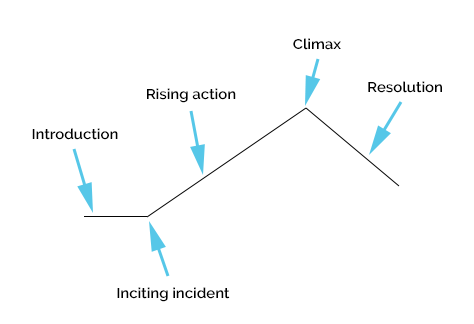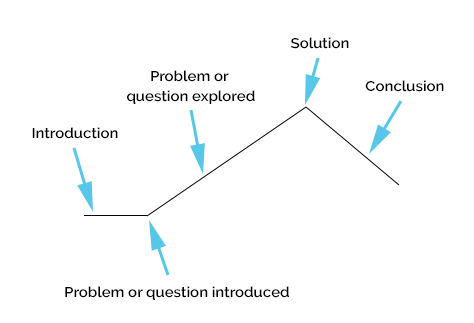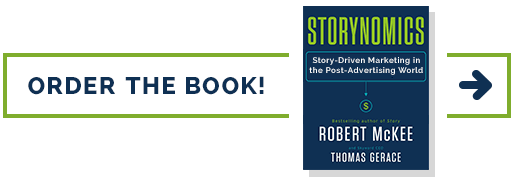Content Creation
How to Use Story Structure with Informative Content Marketing Pieces
By Nicole D'Angelo on September 21, 2018
We know by now that great content marketing is powered by storytelling.
But often, when organizations get their content marketing engines up and running, they face a dilemma in how exactly to make storytelling work as a medium for all of their brand's messaging. For content marketers looking to produce a lot of content to fill out an entire month's (or even quarter's) content calendar, the easiest forms to turn to are how-tos, listicles, and other fact-focused pieces.
Most of us wouldn't call these informative or summary pieces "stories" in a traditional sense. They appear more like briefings or tactical overviews than materials with a clear narrative structure or overarching argument. Yet these types of content definitely still have a place in the content marketing mix, and they often drive excellent traffic and engagement.
Does the success of traditional non-story content mean that it's time to dismiss discussions of brand storytelling as nothing more than big ideas and buzzwords?
Short answer: No. Long answer: Depends on your definition of "story."
It's true that there is a place in content marketing for pieces that aren't strictly stories. While those how-tos, listicles, and thought leadership content aren't stories in the most literal sense, you can still use a storytelling structure when creating them.
That's because the power of story in creating messages is universal. The most basic building blocks of story structure are elements designed to capture and keep our attention. If you understand what those building blocks are and how they work, you can apply them to any form of media-and you'll be able to "storify" even the least story-like content marketing piece.
The Elements of Story Structure
To start, let's get into the fundamentals by reviewing a diagram you probably saw way back in high school English class: Freytag's Pyramid.

This is an incredibly simplified take on story structure, but it works best for our purposes. In it, you'll see that a story is broken into five parts: the introduction, the inciting incident, the rising action, the climax, and the resolution.
The introduction is when you both hook the audience's attention and give them any background information they may need. This is followed by the inciting incident, which is the moment when a story's primary conflict is introduced. As the characters attempt to solve this conflict, they face a series of successive complications, all of which fall under the category of rising action.
The reason this action is "rising" is because throughout it all, tension is gradually building. The stakes grow more and more dire until the characters must take an action that solves (or fails to solve) the conflict once and for all. This point is known as the climax. After that problem-addressing climax occurs, all remaining loose ends are tied up during the resolution.
But how can this model be applied to a factual or tactical piece of content? Consider how a well-written article is usually structured.
There's often an introduction that both hooks the reader and provides them with background on what the piece will be discussing. Generally, this introductory section ends with a sentence or two that explicitly states what main idea the piece will present or what problem it will explore.
Then, the bulk of the article elaborates upon that central concept. Most of the time, writers will attempt to structure their pieces so that the more interesting points are saved until the end in order to maintain reader interest throughout, improving their content's overall SEO through factors like scroll-depth and total time spent on a page. Finally, the article presents a solution to the piece's main problem, and all the loose ends are tied up in a conclusion.
When examined from this perspective, factual articles and stories start to sound really similar. They are both, at their most basic level, made up of the following parts:
- An introductory section that hooks the reader's attention
- A moment when the main problem is introduced
- An exploration of the problem
- A final solution
- A conclusion that ties everything together
In fact, the structure of informative posts can be illustrated by a pyramid of its own that shares many of the key features of the traditional model:

The Structure of Audience Engagement
This type of structure applies to almost every form of sequential art. For example, songs are written on similar principles-an introductory riff is played, the main melodic themes are introduced, those themes are built on in increasingly interesting ways until they all come together in a moment of high intensity, and then the song draws to a conclusion.
Once you learn to recognize this pattern, you'll begin to see it everywhere. That's because it appeals to the most basic way we as people process information.
Image attribution: Jan Střecha
As most content marketers know, people will only pay attention to your content if you give them a good reason to do so. Once you hook your audience's attention with a strong introduction, they'll be more interested in hearing your main idea. You won't have much time before their attention starts to wander again, though, so you'll have to find ways to elaborate on that main idea, and each elaboration needs to be more interesting than the last to keep them engaged all the way through.
If there's a problem or question they want the answers to, they'll stick around until they find that answer. Finally, once you've said all you need to say, you'll need to sum up your main ideas in a way that leaves your readers feeling satisfied.
This pattern is how stories keep you invested from the beginning until the very end. But it's also how you'll be able to craft content that will both grab your audience's attention and prevent them from bouncing until the end of the "story" is reached.
Storifying Every Type of Content
It can be difficult to see how this formula could be applied to how-tos and listicles. But believe it or not, you can storify those types of content, too.
How-tos, for example, are more than simple instructions. Instead, you can think of them as narratives starring your reader.
The story opens on your reader facing a problem. It's important to note that there's no need to make up a fictionalized character. ("Joe's a content marketer. He knows that he needs to storify his content, but he's not sure how.") If you're addressing an authentic problem your audience regularly faces, they will find the comparison to their own lives and subconsciously project themselves into the piece as the "protagonist."
(Case in point: While reading this article, have you been wondering if you can apply it to your own content? That's because you're the protagonist of this particular piece.)
After the introduction grabs the reader's attention by raising a relatable issue, you can present the article's main idea in an "inciting incident." In the case of a how-to piece, the exploration of the problem and the problem's solution are described at the same time. But by walking the reader through the process step-by-step, they can feel as though they're being taken on a narrative journey from first experiencing a problem to ultimately solving it.
Even listicles can take some inspiration from narrative structure. Again, your reader is your protagonist, and you begin the story by raising a relatable problem. From there, you can explore the problem by listing out potential answers or solutions-keeping the most interesting ones until the end in order to mimic a story's rising action.
Image attribution: Brent Gorwin
Finally, no matter the type of content, it's almost always a good idea to end with a short conclusion that ties it all together in a way that encourages the reader to use what they've just learned.
Using the Resonance of Stories
Let's recap by breaking down the experience you just had reading this piece.
I started by introducing a concept that you, as a content marketer, can probably relate to-the dilemma of wanting to tell stories but finding it more practical to produce other types of content. I then promised that you could solve that problem by learning to apply narrative structure to informative or technical content.
I elaborated on that point by explaining what narrative structure looks like and describing how it applies to factual articles. I gave some deeper insights into how narrative structure is designed to grab attention. Then, toward the end, I addressed what's probably the most salient point for you-how to apply this concept to common types of content like how-tos and listicles.
Now I'm going to leave you with a short conclusion that ties everything together-because this piece follows narrative structure, too.
Of course, not every piece is going to contain every part of Freytag's Pyramid. But every good piece of content will grab and hold the reader's attention in the way I've outlined. By keeping these concepts in mind, you'll be able to evoke the resonance of a good story while still producing informational thought leadership content.
Everyone knows the importance of storytelling. But good stories are more than characters, settings, and themes. Good stories are, at their very heart, founded on structure. Once you've mastered that structure, you can use it to make compelling "stories" regardless of the type of content you're actually creating.
For more on how brands can use storytelling to revolutionize their marketing, order your copy of Storynomics by award-winning teacher of screenwriting Robert McKee and Skyword founder and CEO Tom Gerace, or attend an in-person Storynomics seminar.
Featured image attribution: Andrew Le



